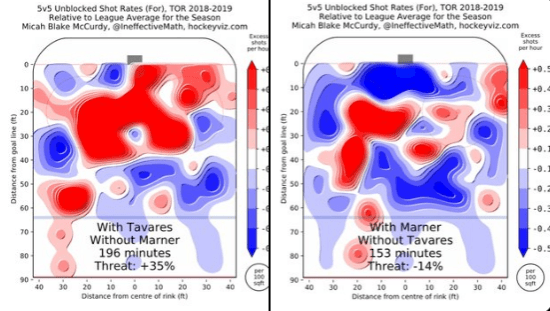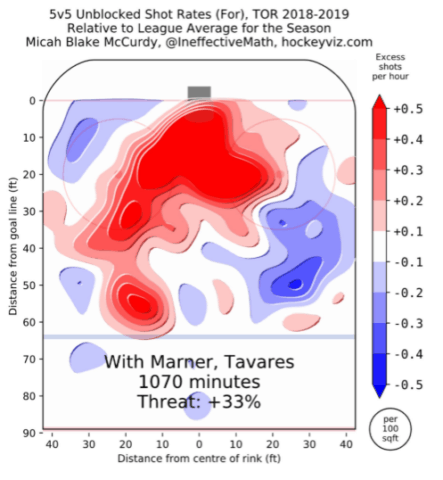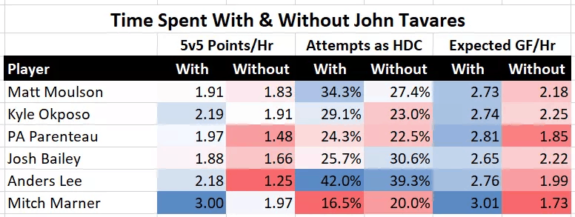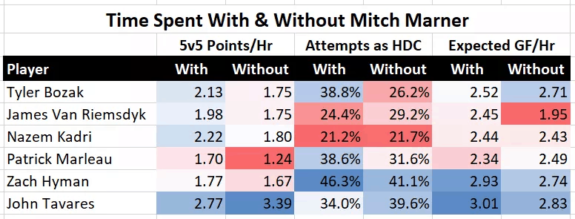The NHL Network recently released their list of top-20 centres. Toronto Maple Leafs John Tavares and Auston Matthews were ranked fifth and sixth, respectively, among centres, and deservedly so. The real controversy came on Aug. 11 when the network unveiled their top-20 winger rankings.
At fifth overall, the NHL Network ranked Mitch Marner ahead of Leon Draisaitl, Johnny Gaudreau, Artemi Panarin, Mark Stone, Taylor Hall, and other big names.
Here are arguments for why Marner might be a top-five winger, and why each of those arguments ultimately falls flat.
He Scores a Lot of Points
If you’re judging players in the simplest way possible, then there may be an argument to rank Marner as the fifth-best winger in the league: His 94 points ranked fifth among wingers last season. But if you’re going down the route of ranking players solely based on point totals, then why was someone like Draisaitl, who scored 50 goals and 105 points, behind Marner, who scored just 26 goals and 11 fewer points? Why was Gaudreau, who scored 36 goals and 99 points, ranked behind Marner as well? The logic doesn’t check out.

The NHL Network’s rankings are even more questionable when we consider a larger sample size. Over the past three seasons, Marner has averaged 75 points. That’s impressive, but it places him 11th among wingers – not fifth – over that span. Blake Wheeler, Draisaitl, Panarin, Claude Giroux, Phil Kessel, Gaudreau, and David Pastrnak have all scored more points and goals than Marner over that span, yet all were ranked lower.
Also, consider the fact that goals are undeniably more valuable (and more difficult to produce) than assists. Last season, Marner ranked 39th among wingers in goal scoring, and 45th over the last three seasons. He is one of the best play-makers in the league, but he’s not a prolific goal scorer.
He Drives His Line
Perhaps the greatest myth about Marner is that he carries the offence and drives his own line. The shifty winger creates his fair share of chances, and fans are aware of the flashy passes he makes but, on the whole, he doesn’t drive play on his own.

On the left we see a 5-on-5 shot map of Tavares without Marner. The red pool in front of the net indicates an excess of shots from that area, and the threat level indicates that Tavares and his linemates were able to create 35 percent more scoring chances than average. Marner without Tavares, on the other hand, looks significantly less dangerous: The front of the net is dark blue, meaning that fewer shots from dangerous areas were taken when Marner was on the ice without Tavares, and the scoring threat was well below average.
Of course, we know that when Marner and Tavares play together the results are outstanding:

The point is that Tavares is the one driving the line, as he has a history of doing. Jeff Veillette wrote a great piece on Marner and his contract comparables earlier this year, and in that article he illustrated just how much Tavares is able to boost his linemates. Notice how each of Tavares’ linemates over the past several seasons has a notable increase in both 5-on-5 points per hour, as well as expected goals for per hour.

Marner, meanwhile, does not always have the same positive effect. Most of his linemates experience increased point production (although Tavares didn’t), but only half of them saw an increase in high danger chances and expected goals.

That’s not to say that Marner is without offensive talent; it simply demonstrates that he is not the driving force that many believe him to be. Tavares was the key to his line’s success last season, as he has been throughout his career and he’s the main reason behind Marner’s breakout performance last season.
He’s the Maple Leafs’ Best Player
“This is no knock to his teammates because he’s got world-class teammates in Auston Matthews and John Tavares,” said Mike Rupp of the NHL Network. “[Marner] has been the best Toronto Maple Leafs player for the last two years. He’s been their best player, their most valuable player.”

There is no doubting Marner’s talent, potential, work ethic, and infectious love for the game, but to suggest that he is Toronto’s best and most valuable player is ridiculous. Again, the only way that one could reach that conclusion is by looking at point totals alone.
Over the last two seasons, Marner is indeed the Maple Leafs’ top producer with 163 points in 164 games. However, that’s a worse ratio than both Matthews (136 points in 130 games) and Tavares (88 points in 80 games). Not to mention that both Matthews and Tavares play centre and score goals at a much higher pace than Marner: Matthews has 71 goals over the past two seasons, while Tavares’ 47 goals last season falls just shy of Marner’s mark of 48 over the past two seasons.

One could even make a case that Morgan Rielly, who broke out with 72 points while playing over 23 minutes per night, was more valuable than Marner last season. Frederik Andersen, who has played more minutes than any other goaltender over the past three seasons, must be in that conversation as well.
This is not to discredit Marner: He had a terrific season and his potential remains sky high. The point is to temper expectations by accounting for the surrounding context, which paints a picture of a player that, while extremely talented, likely over-performed or was at least greatly assisted by a genuine top-five centre in Tavares.

Still unsigned, it remains to be seen what kind of contract Marner and the Maple Leafs will settle on. Given the hype that’s now associated with his name, plus the likely record-setting deal that he’s bound to sign, Marner will be expected to follow up his 94-point campaign with an even better one next season.
Stats from https://www.hockey-reference.com/ and http://www.naturalstattrick.com/